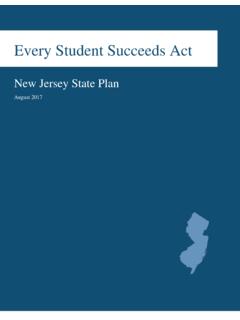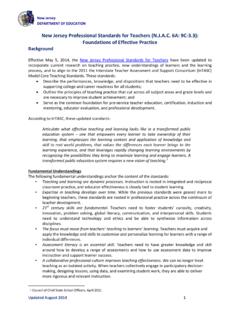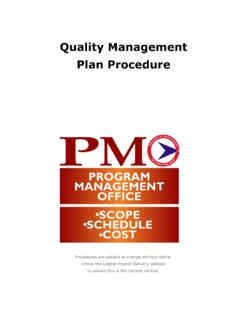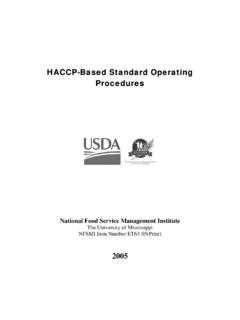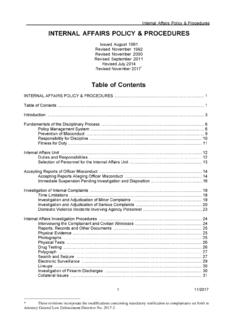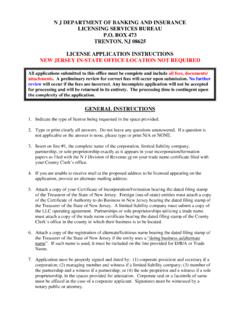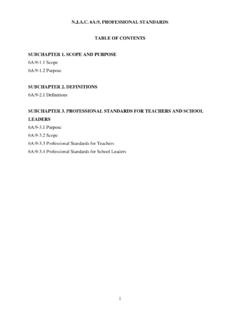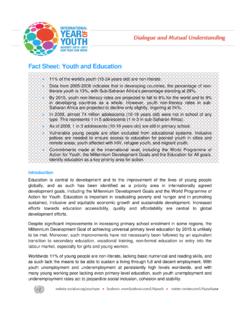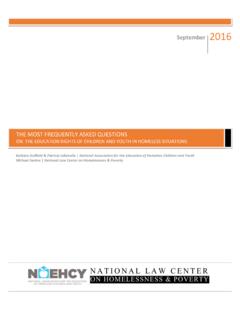Transcription of Youth Development Youth Leadership - New Jersey
1 C1 A BACKGROUND PAPERY outh Development & Youth LeadershipYouth Development & Youth LeadershipPAPER PREPARED BY:Andrea EdelmanPatricia GillKatey ComerfordMindy LarsonRebecca HareNational Collaborative on Workforce and Disability for YouthJune 2004 The National Collaborative on Workforce and Disability for Youth (NCWD/ Youth ) is composed of partners withexpertise in disability, education , employment, and workforce Development issues. NCWD/ Youth is housed at theInstitute for Educational Leadership in Washington, DC. The Collaborative is charged with assisting state and localworkforce Development systems to integrate Youth with disabilities into their service under a grant supported by the Office of Disability Employment Policy of the U. S. Department of Labor,grant # E-9-4-1-0070. The opinions contained in this publication are those of the grantee/contractor and do notnecessarily reflect those of the U. S. Department of Labor.
2 NCWD/Youth1-877-871-0744 (toll free) 1 PurposeAll effective Youth programs have Youth developmentat their core. Effective Youth Leadership programs buildon solid Youth Development principles, with anemphasis on those areas of Development and programcomponents that support Youth Leadership . This paperhas been created by the National Collaborative onWorkforce and Disability for Youth (NCWD/ Youth ) toassist Youth service practitioners, administrators, andpolicy makers in defining, differentiating, andproviding Youth Development and Youth leadershipprograms and activities, which are importantcomponents of the Workforce Investment Act (WIA).BackgroundYouth Development in Workforce DevelopmentIn 1994, the National Youth Employment Coalition(NYEC) held a series of meetings to discuss the state ofyouth training and employment programs fordisadvantaged Youth in America. Based on thesemeetings, a report was sent to the US Secretary ofLabor outlining the need for a comprehensive nationalyouth policy (National Youth Employment Coalition,1994).
3 The suggested policy would cross sectors ofgovernment and fields of service delivery includingemployment and training, health and human services,housing and community Development , secondary andpostsecondary education , and juvenile justice, andwould not only provide services to Youth but wouldalso value Youth as a resource for programdevelopment. The comprehensive Youth policy wouldput in place a coherent and long-term strategy thatwould contribute to positive Youth Development insuch a way that no one federal agency could possiblyachieve. As a result of these recommendations by NYEC andothers, the Youth provisions of WIA (1998) fused youthdevelopment principles with traditional workforcedevelopment. This convergence reflected the growingconsensus that the most effective Youth initiatives arethe ones that focus on a wide range of developmentalneeds. WIA offers comprehensive Youth services emphasizinga systematic, consolidated approach geared towardlong-term workforce preparation.
4 This comprehensiveapproach for Youth consists of 10 required programelements: Tutoring, study skills training, and instruction lead-ing to completion of secondary school, includingdropout prevention strategies; Youth Development & Youth LeadershipYouth Development & Youth Leadership 2 Alternative secondary school services, as appropriate; Summer employment opportunities that are directlylinked to academic and occupational learning; Paid and unpaid work experiences, including intern-ships and job shadowing, as appropriate; Occupational skill training, as appropriate; Leadership Development opportunities(emphasisadded), which may include community service andpeer-centered activities encouraging responsibilityand other positive social behaviors during non-schoolhours; Supportive services; Adult mentoring for the period of participation and asubsequent period, for a total of not less than twelvemonths; Follow-up services for not less than twelve months afterthe completion of participation, as appropriate; and Comprehensive guidance and counseling, which mayinclude drug and alcohol abuse counseling and refer-ral, as appropriate.
5 WIA s inclusion of Leadership Development activities asone of the 10 required program elements is consistentwith research (National Research Council and Instituteof Medicine, 2002; Gambone, Klem, & Connell, 2002;Sipe, Ma, & Gambone, 1998) showing that effectiveyouth initiatives give young people opportunities totake on new roles and responsibilities through theprogram and the Development for Youth with DisabilitiesAlthough research shows that Youth who participate inyouth Development and Youth Leadership experiencesare more likely to do well in school, be involved intheir community and positively transition throughadolescence to adulthood, Youth with disabilities haveoften been isolated from mainstream youthdevelopment programs. To ensure equal access to allthe benefits of the Youth -focused provisions in WIA, anumber of organizations devoted to promotingopportunities for persons with disabilities have becomeactive in the arena of comprehensive youthdevelopment and workforce Development .
6 Theseorganizations seek to replicate successful youthdevelopment activities for all Youth while maintaininga focus on areas of need specific to Youth withdisabilities, including exposures to mentors and rolemodels with and without disabilities, and anunderstanding of disability history, culture, and publicpolicy issues as well as their rights and long history of adult-driven advocacy, Leadership ,and activism within the disability communitycombined with the desire to see the emergence of thenext generation of young leaders with disabilities,resulted in the 1990s serving as the backdrop for theemergence of a Youth Leadership and youthdevelopment As a result of emerging views around self-determination, leaders in the disability community andtheir federal partners, sought to involve Youth in theplanning, Development , and implementation of anannual conference focusing on the leadershipdevelopment of young people with disabilities.
7 In 1990,following the first two national conferences for youthwith disabilities sponsored by the Social SecurityAdministration and other federal agencies, a youngperson was appointed as the first chair of the NationalYouth Leadership Council. The Chair was charged withplanning and implementing the annual conference,which eventually evolved from its concept as anannual event into a year-round network called theNational Youth Leadership Network (NYLN). It ishoused at Oregon Health and Sciences University(OHSU) Center for Self-Determination, with additionalsupport provided by the Academy for EducationalDevelopment (AED). NYLN has grown into a formal year-round network ofcross-disability Youth leaders from the and itsterritories. Unique in its Development of Youth -ledresearch studies, the NYLN has created an annualFuture Directions Agenda written in Youth speak and based on feedback from the conferenceparticipants around the prevailing issues facing youthwith disabilities today.
8 Past agendas have included:increasing opportunities for meaningful employment;the education and preparation of Youth withdisabilities around transition issues; and the need topromote disability culture and history. The leadershipof the NYLN has also developed formal and informalmentorship programs. These programs include peer-to-peer, federal government mentors, and disability 3 community mentors. Deeply rooted in the disabilitycommunity, NYLN is dedicated to advancing the nextgeneration of disability leaders and seeks to accomplishthe following goals: Promote Leadership Development , education , andemployment to ensure that all Youth with disabilitieshave the opportunity to attain their maximum andunique potential; Foster the inclusion of young leaders with disabilitiesinto all aspects of society at national, state, and locallevels; Communicate about issues important to Youth withdisabilities and the policies and practices that affecttheir Collaborative on Workforce and Disability for Youth (NCWD/ Youth )In 2001, the Office of Disability Employment Policy(ODEP) at the US Department of Labor (DOL) fundeda national technical assistance center designed to assistthe workforce Development community in addressingissues affecting the employment of Youth withdisabilities.
9 As a result, NCWD/ Youth was formedwith the following three goals: (1) supporting state andlocal policies that promote full access to high qualityservices for Youth with disabilities; (2) strengtheningthe services provided by organizations responsible fordelivery of workforce Development services; and (3)improving the awareness, knowledge, and skills ofindividuals responsible for providing direct services toyouth. Because Leadership Development and youthdevelopment have such a prominent role in WIA,NCWD/ Youth is taking the important first step ofidentifying essential areas of Development andprogram components for Youth Leadership and youthdevelopment programs to ensure the leadershipcapabilities of Youth with disabilities. Definitions: Youth Development and Youth LeadershipOften, and mistakenly, the terms Youth Development and Youth Leadership are used interchangeably. Inorder to differentiate between these two conceptsclearly, NCWD/ Youth reviewed a range of sources onyouth Development and Youth Leadership , includingcurrent literature, curricula, and program models, andexamined different definitions and descriptions ofprogram components of each.
10 (For a comparative chartof the major Youth Development models reviewed, seeAppendix A: Comparison of Youth DevelopmentModels.). The goal was to identify a single workingdefinition of each of Youth Development typicallycharacterize it as a process or approach in which youngpeople become competent or develop competenciesnecessary to be successful and meet challenges (Centerfor Youth Development and Policy Research, 1996;National Collaboration for Youth , 2003; Pittman, 1991; Youth Development Institute, ; Youth DevelopmentBlock Grant, 1995). Most definitions also identify eitherspecific desired outcomes that young people need toachieve or critical tasks they must accomplish in orderto achieve these positive outcomes (Astroth, Brown,Poore, & Timm, 2002; US Department of Heath andHuman Services, 1996; Center for Youth Developmentand Policy Research, 1996; Youth DevelopmentInstitute, ; Youth Development Block Grant, 1995;Carnegie Council on Adolescent Development , 1989).
